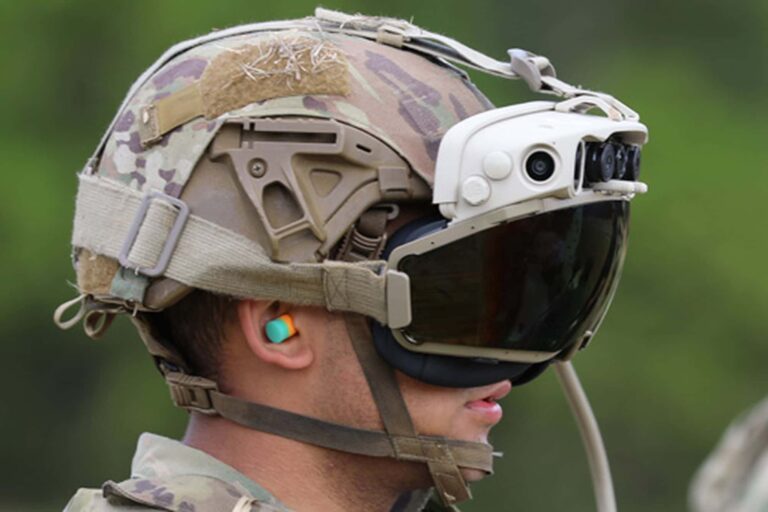
3
D technology first appeared in the military in the 1980s, when virtual battlefield simulators were used for training soldiers in core tactics and navigation. These 3D simulators could generate combat environments and terrain in a rudimentary form. However, they were limited in what they could offer regarding realism and one-to-one interaction.
VR became popular in the military in the 1990s because it allowed for the creation of flight and vehicle operation simulators for training military personnel.
By the 2000s, 3D software had advanced exponentially, with applications like Google Earth enabling precise terrain mapping and enabling military leaders to view terrain in three dimensions.
The 2010s saw considerable advancements in 3D and VR technologies, with the implementation of Virtual Battle Space. This system enabled soldiers to choose from individual combat training to large-scale military exercises.
AR and Mixed Reality have come to the forefront in the 2020s as the military strives for real-time battlefield awareness. This has developed over the past five years through the U.S. Army’s Integrated Visual Augmentation System (IVAS) program. First contracted with Microsoft, and more recently with Anduril, the goal is for digital data to annotate physical environments, including real-time mission data, enemy locations, and tactical information.
Military personnel can also use VR systems to control drones in real time to infiltrate concealed or dangerous enemy terrain. They can then receive 3D feedback confirming locations and evolving enemy threats. Haptic feedback has also been integrated within VR systems to simulate senses and allow soldiers to experience a more realistic simulation.
How have 3D and VR been used on the battlefield?
3D and VR have been used in many ways to enhance battlefield performance.
Training Simulations
3D and VR have revolutionized military training for the battlefield. VR has been used to create training simulations that soldiers can undertake before entering actual combat zones. This eliminates risk and allows them to strategize and practice replayable combat scenarios, brainstorm tactical maneuvers, and assign the correct equipment usage in a controlled environment. It also gives soldiers real-time feedback to alter and adapt their decisions based on evolving threats, fostering better teamwork and leadership skills, and enhancing their skill sets.
Planning Missions with 3D Models
3D Models have played a vital role in planning and strategizing, helping the military visualize terrain and target enemy positions. VR can also simulate battlefield conditions, allowing military leaders to plan logistical routes. They can also integrate real-time updates into the simulation to assess battlefield conditions, unexpected threats, and possible outcomes. This enables them to identify possible life-threatening mistakes and make adaptations that benefit their soldiers and mission.
Medical Aid Deployment
3D Rendering and VR have been used for medical diagnostics, allowing medics on the field to assess quickly and tend to injuries. They have also played a crucial role in training battlefield medics for emergency response protocols and implementing life-saving medical procedures.
Enhanced Communication Coordination
3D and VR technologies facilitate seamless global communication among military units, improving collaboration and responsiveness in high-pressure, time-critical situations. Combined with the capability to overlay digital information, these technologies empower the chain of command to make well-informed decisions that safeguard their soldiers’ lives in perilous situations.
Mission Analysis
3D Software can be used to debrief battlefield events, scrutinizing what went well and what improvements are needed. This allows soldiers to learn, adapt, and restrategize for future battle experiences and hone their skills to achieve successful mission outcomes.
Psychological Aftercare and Recovery
VR can design immersive environments to assist soldiers in coping with PTSD while also supporting the development of effective coping strategies alongside physical activities in rehabilitation programs.
Wargaming
3D and VR technology could be used to create large-scale battle scenarios so military leaders can model the behavior of enemy forces and anticipate possible outcomes with AI, which will help soldiers prepare and adapt to any unexpected scenario on the battlefield.
Psychological Conditioning
3D and VR can help soldiers mentally prepare for the psychological challenges ahead on the battlefield. By creating unexpected military stresses and triggers or challenges before their mission, they can preempt, process, and learn to control their emotions in a controlled virtual setting and receive the support they need to navigate unpredictable scenarios before dropping into enemy terrain.
The Future Of History: 13 Ways XR Transform Historic Preservation
How will 3D and VR influence the battlefield in the future?
3D and VR can revolutionize future battlefields by enhancing strategic planning, training, and real-time combat operations. They can also improve military campaigns in several ways.
Tactical Warfare
3D and VR can remove barriers in the future, with military forces worldwide able to collaborate, plan worldwide humanitarian rescue campaigns, and share reconnaissance and intelligence much more quickly through 3D Virtual Spaces.
Virtual Military Campaigns
The military will be able to use 3D and VR technology to create realistic holographic avatars and project digital clones of themselves into dangerous areas to patrol and gather intelligence.
Real-Time Updates
3D and VR technology can provide military leaders with real-time views of situations. This enables them to view enemy movements and analyze the situation from a 360-degree perspective, removing the need for rigid, static maps.
Remote Neural-Linked VR Controlled Warfare
Soldiers could pilot and control drones or robots through neural interfaces. This could allow soldiers to interact in battles from a safe distance and increase initiative battle response times, enhancing mission precision and ensuring transparent decision-making.
World’s Smallest VR Headset Starts Strong Despite Production Snag
Conclusion
3D and VR have provided unprecedented advancements on the battlefield. By offering real-time feedback and realistic training simulations, military leaders can enhance soldiers’ abilities and improve their reactions and response time in high-stress scenarios. They will also provide a safer alternative to traditional training and psychological aftercare methods in the long term. As these technologies evolve, they will push the boundaries of strategic thinking and planning in military operations, making them a vital tool in any future combat scenario.
Header image credit: Joanna Kosinska on Unsplash

Ion Hatzithomas is CEO at RenderHub

